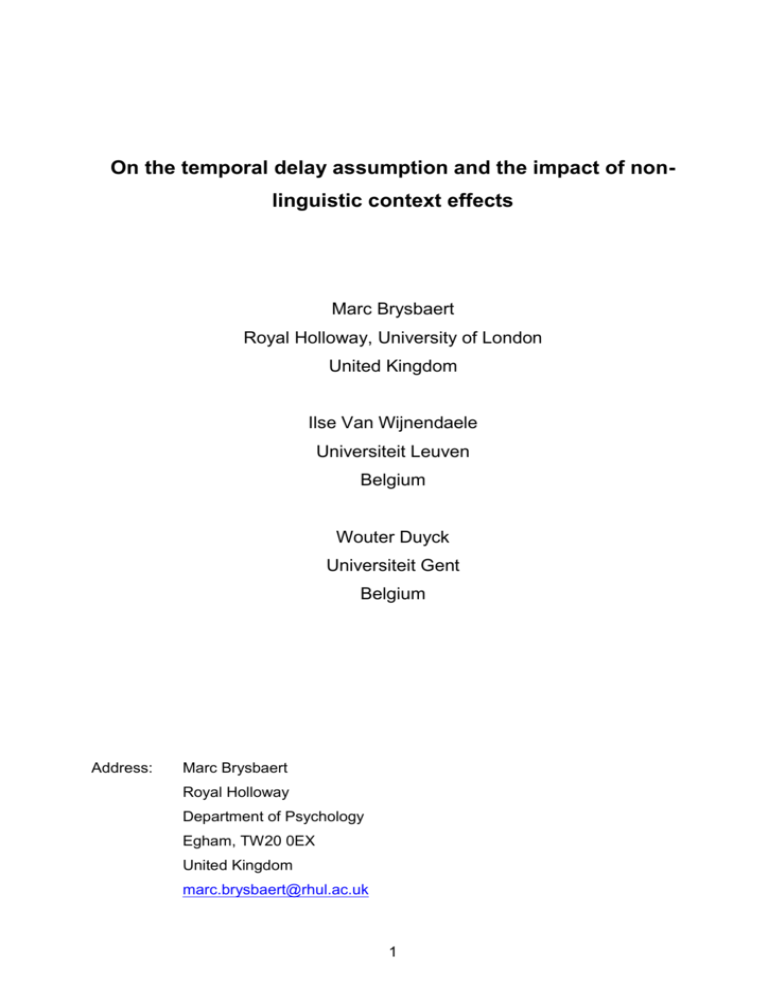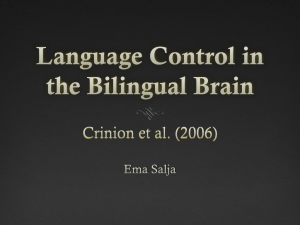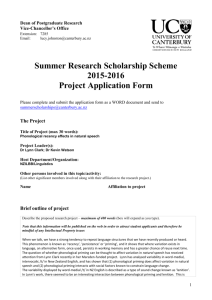On the temporal delay assumption and the impact of non
advertisement

On the temporal delay assumption and the impact of nonlinguistic context effects Marc Brysbaert Royal Holloway, University of London United Kingdom Ilse Van Wijnendaele Universiteit Leuven Belgium Wouter Duyck Universiteit Gent Belgium Address: Marc Brysbaert Royal Holloway Department of Psychology Egham, TW20 0EX United Kingdom marc.brysbaert@rhul.ac.uk 1 It is not easy to comment on Dijkstra and Van Heuven’s model, because there are many more aspects we agree with than aspects we feel uncomfortable about. Indeed, the BIA model has played an enormous role in showing us how bilingual visual word recognition can be achieved without recurrence to the intuitively appealing –but wrong– ideas of separate, language-specific lexicons and language-selective access. As in many other research areas, a working computational model has been much more influential in convincing critical readers (and researchers) than any series of empirical findings. The BIA+ model inherits this strength and hopefully in the coming years will be implemented in enough detail to exceed its predecessor. In the rest of this comment, we would like to put a cautionary note behind the temporal delay assumption introduced in the target article, and provide some additional corroborating evidence for the lack of non-linguistic effects on early processes in the identification system. The “temporal delay assumption” claims that L2 phonological and semantic codes are delayed in activation relative to L1 codes. This seems to imply that the delay will be substantial and constant for all types of words (only depending on the proficiency of the bilingual). With respect to the orthography-phonology conversion, we have quite strong evidence that this is not the case. If the activation of phonology in L2 were rather slow (and/or weak), then one would expect less impact of phonology in second language processing than in first language processing. Probably the best way to study the importance of phonological coding in visual word recognition is to make use of the masked priming paradigm. In this paradigm, a target word (e.g., “side”) is preceded by a tachistoscopically presented homophonic non-word prime that sounds the same (e.g., “syed”) or by a graphemic control prime that shares the same number of letters but does not sound the same (e.g., “soed”). Evidence of phonological encoding is obtained when target word processing is better after the homophonic prime than after the graphemic control prime. Such a homophonic priming effect has been reported in many languages including English, Dutch, and French (see Brysbaert, 2001, for a review). In a series of experiments using Dutch and French target words, we showed that the magnitude of the homophonic priming effect was equally large in L2 as in L1 (Brysbaert, in press; Brysbaert, Van Dyck, & Van de Poel, 1999; Van Wijnendaele & Brysbaert, 2002), suggesting that the activation of phonological information from a visually presented word is equally strong in both languages. So, the French word “faim” [hunger] had more chances of being recognised after the homophonic prime “fain” than 2 after the graphemic control prime “faic”, both for French-Dutch bilinguals and for DutchFrench bilinguals. The same effect was found with Dutch target words like “fijn” [fine] preceded by the primes “fein” and “foun”. These studies made use of bilinguals with a clear dominance of the first language (i.e., non-balanced bilinguals). Apart from the above empirical findings, there are also theoretical reasons why the activation of L2 phonology need not always trail behind the L1 activation. When two languages share the same alphabet, they are also likely to have many similar lettersound correspondences, in particular for the consonants. For instance, the letters “b”, “c” and “d” stand for very much the same sounds in Dutch and French, and there are no reasons to believe why L2 processing would not make use of these already existing, compatible L1 conversions. Furthermore, a number of letter signs (or letter combinations) may be unique to L2 and if these are encountered frequently enough, their cumulative frequency may outnumber the cumulative frequency of less common L1 conversions. Again, any learning-based system would predict that these L2 conversions are completed faster than the less frequent L1 conversions (unless both are at ceiling level, in which case conversion times will be the same). Finally, there are the interesting instances where the L2 letter-sound correspondences are incompatible with the existing L1 letter-sound correspondences. For instance, the grapheme “ee” is pronounced /i:/ in English (as in “meet”) but /e:/ in Dutch (as in “leed” [sorrow]). Depending on the model of grapheme-phoneme conversions, one has to predict that such L2 conversions either do not happen (if the conversions are rule-based) or start to interfere with the original L1 conversions (as in connectionist-type learning models; see Van Wijnendaele & Brysbaert, 2002, for a detailed discussion). In the latter case, L2 proficiently will not only have implications for the processing of L2 but also for the processing of words in the mother tongue (Brysbaert, in press). Again, the end result is not simply a delay of L2 codes relative to L1 codes, but interactions between both types of codes that are much more dynamic than implied by the “temporal delay assumption”. Very much the same story could probably be told about the activation of semantics from lexical orthography and phonology. For those words that have exactly the same, well-defined meaning in L1 and L2, it is probably relatively easy to activate the existing patterns of semantic features from the new word forms. A typical class of such words are the number words, which have exactly the same meaning in different languages. Tzelgov, Yehene, Kotler, and Alon (2000) showed that arbitrary symbols 3 representing magnitudes after a short learning phase evoke the same semantic effects as the original Arabic digits. For instance, when digit pairs are shown in two fonts with different physical magnitudes, participants find it more difficult to indicate that 8 is the smaller symbol in the pair “2 – 8” than that 8 is the larger symbol in the pair “2 – 8”. This effect is referred to as the Stroop-like size congruity effect. Tzelgov et al. observed that after a short training session the size congruity effect can be obtained with any pair of arbitrary symbols that have been introduced as “alternative digits”. Duyck and Brysbaert (in preparation) wondered whether a similar effect would occur in number translation. First, they showed that bilinguals need less time to translate small verbal numerals (e.g. “two”) than large numerals (“eight”), as could be expected on the basis of the finding that large numbers need more time to activate their semantic representation than small numbers (Brysbaert, 1995). Then, they trained a group of participants for half an hour on unknown, so-called “Estonian number words” and had them translate these words. Exactly the same number-magnitude effect was obtained as in the original study (which involved two well-known languages), strongly suggesting that the translation of the new Estonian words was semantically mediated as well. So, the activation of semantics from L2 words need not take longer than the activation from L1 words, provided that the meanings of both classes of words are the same and clearly specified. This will be particularly true for those words that in addition to full semantic overlap, also share form properties (i.e., cognates). Less rapid activation of semantics can be expected for L2 words that cannot profit from existing L1 word-meaning mappings (because they do not have literal translations) or that contradict the existing L1 mappings (as could be the case for homographs). Again, most learning algorithms would predict that the introduction of inconsistencies in the mappings due to the learning of a new language have implications not only for the speed of the L2 conversions, but also are likely to affect the existing L1 conversions. The above paragraphs remind us that a verbal description of a computational model is not the same as a fully implemented and running model. Therefore, we are eager to see the future implementations of the BIA+ model. Our hunch is that the temporal delay assumption will be much more difficult to implement than the scenario we have outline above. In the remainder, we would like to finish with a more positive note, showing that the orthography-phonology conversion part of the word identification system is indeed impervious to the non-linguistic context. 4 In the priming studies described above, we not only looked at intra-language phonological priming but also at cross-language priming. In particular, we showed that not only is it possible to prime an L2 target word with an L2 homophonic prime, but also to prime an L2 target word with an L1 homophonic prime. So, for a Dutch-English bilingual (but not for an English monolingual), it is possible to prime the target word “blame” with the non-word “bleem”, because “bleem” is a pseudohomophone of the target “blame” according to the Dutch spelling-sound correspondences. In addition, we showed that it is equally possible to prime an L1 target word with a L2 homophonic prime. So, the “bleem-blame” example also works with English-Dutch bilinguals. (Incidentally, this again shows that L2 phonology is not simply delayed relative to L1 phonology.) Van Wijnendaele (2002, Chapter 7) wondered whether the cross-lingual L2 on L1 phonological priming effect depended on the participants being aware of the bilingual nature of the study (as implied by Grosjean’s “language mode”). To find out, she asked two groups of Dutch-French bilinguals (university students from Leuven) to take part in a Dutch word recognition experiment. The first group of students was told that the experiment was part of a bilingual word recognition study program and they first completed a French word recognition experiment before they started with “the Dutch part”. The second group of students was simply told that the experimenter was interested in Dutch word recognition (i.e., the mother language of the students and also the language used at the university). The French language was not mentioned (as a matter of fact, special precautions were taken to make sure that the students could not find out that the experiment was part of a PhD on bilingual word recognition). The students were told that upper-case target words would be presented briefly between two rows of hash-signs (########). Their task was to try to recognise the word. Unknown to the students, the targets words were preceded by a tachistoscopically presented, lower-case prime (presented too shortly to be visible). Half of the primes were Dutch non-words (homophonic or controls, such as “fein/foun” for the target word “FIJN” [nice]); half were French non-words (e.g. “deuque/delu” for the target word “DEUK” [dent]). The Dutch pseudohomophones sounded like the target words if the Dutch letter-sound conversions were used; the French pseudohomophones sounded like the target words if the French letter-sound conversions were used. The hypotheses were: (a) that the students would be more likely to identify the words after a 5 homophonic prime than after a graphemic control prime, and (b) if Grosjean is right and if bilinguals are able to de-activate one part of their language system, we would not observe priming from French L2 primes on Dutch L1 words when participants are not aware of the fact that the French language matters for good performance (i.e. those participants in the monolingual mode). The results of the study are displayed in Table 1. Table 1: Percentage word identification as a function of language mode and prime type (for details, see Van Wijnendaele, 2002, Chapter 7) Bilingual mode Monolingual mode deuque-DEUK delu-DEUK priming effect 54% 49% 5% 65% 58% 7% fein-FIJN foun-FIJN priming effect 71% 62% 9% 69% 59% 10% As can be seen in Table 1, there was no sign of any significant modulation of the phonological priming effect as a function of the language mode of the participants. As a matter of fact, the priming effect was slightly larger for the group of students who were not aware of the fact that knowledge of French mattered (the monolingual mode) than for the students who had been informed about the importance of the French language (the bilingual language mode). The only difference between the groups that could have some implications was the tendency of the participants in the bilingual mode to recognise less L1 target words when these followed a L2 prime (“deuque/delu – DEUK”) than when they followed an L1 prime (“fein/foun – FIJN”; see the first column of Table 1). No such difference was present for the participants in the monolingual mode. This seemed to indicate that there might be some inhibition from L2 on L1, if (a) students are in a bilingual language mode, and (b) there is bottom-up information in the prime strongly pointing to L2. However, two unpublished follow-up studies that tried to replicate this finding, failed. Therefore, it is probably safe to assume, as Dijkstra and Van Heuven do, that the word identification system is impervious to non-linguistic context manipulations. 6 References Brysbaert, M. (1995). Arabic number reading: On the nature of the numerical scale and the origin of phonological recoding. Journal of Experimental Psychology: General, 124, 434-452. Brysbaert, M. (2001). Prelexical phonological coding of visual words in Dutch: Automatic after all. Memory & Cognition, 29, 765-773. Brysbaert, M. (in press). Bilingual visual word recognition: Evidence from masked phonological priming. In S. Kinoshita & S.J. Lupker (Eds.), Masked priming: State-of-the-art. Hove, UK: Psychology Press. Brysbaert, M., Van Dyck, G., & Van de Poel, M. (1999). Visual Word Recognition in Bilinguals: Evidence From Masked Phonological Priming. Journal of Experimental Psychology-Human Perception and Performance, 25(1), 137-148. Duyck W., & Brysbaert M. (in preparation). Forward and backward translation in balanced and unbalanced bilinguals requires conceptual mediation: the magnitude effect in number translation. Tzelgove, J., Yehene, V., Kotler, L., & Alon, A. (2000). Automatic comparisons of artificial digits never compared: Learning linear ordering relations. Journal of Experimental Psychology: Learning, Memory, and Cognition, 26, 103-120. Van Wijnendaele, I. (2002). Cognitieve representatie van tweetaligheid: Visuele woordherkenning bij tweetaligen. Katholieke Universiteit Leuven: PhD thesis Department of Psychology. Van Wijnendaele, I., & Brysbaert, M. (2002). Visual Word Recognition in Bilinguals: Phonological Priming from the Second to the First Language. Journal of Experimental Psychology-Human Perception and Performance, 3, 619-627. 7





